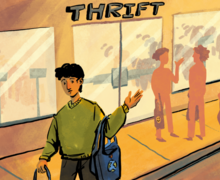Smith: Victim blaming will not eradicate domestic violence
An appalling video showing Baltimore Ravens running back Ray Rice knock out his then fiancée Janay Rice became public after TMZ released the footage last week. After the public read that Janay married Ray Rice one month after the attack many asked:
Why did she stay?
This is the wrong question to ask, and blames the victim. The brutality shown in the surveillance video is something millions of women and men across America deal with every day in private. Asking victims why they stayed will not solve the problem of domestic violence. But understanding the signs and intervening to help stop the complicated cycle of abuse could help find a solution.
One in three women and one in 10 men have experienced physical violence by an intimate partner in their lifetime, according to the Centers for Disease Control and Prevention. Most assaults go unreported and this number could be even higher.
Watching Ray Rice slug Janay Rice in the video from last February and then drag her limp body out of the elevator made many question how Janay could marry such a man. However, we do not see the moments of apology, guilt and then making up for the act that makes an abusive relationship incredibly confusing. It is easy to assess the situation and claim you would run away and report the perpetrator. These women and men are caught in a spider web of ups, downs and fear.
In a trending hashtag #WhyIStayed, men and women came forward about the endless cycle of abuse. “It’s not one day he hits you, it’s everyday he works hard to make you smaller,” Elizabeth Plank, a journalist and activist tweeted.
Another survivor of abuse tweeted, “(I stayed) because he isolated me from friends and family and I had no one to turn to when the abuse started.”
The abuse does not always start from the first moment in a relationship; it is often built up and eats away at the victim. There will be abuse and then shortly after an apology and promise that it will never happen again. People want to see the best in others and will rationalize that the abuse was a one-time incident and the abuse will start again.
The abused are hurt and confused and the abusers have deep underlying issues and illogical reasons for their actions. Abusers often isolate their victim with guilt and shame and day by day belittle them until the victims blame themselves, according to helpguide.org.
To me, there is no excuse for Ray Rice abusing his wife. To begin to eradicate domestic violence, we must first understand how the abuser thinks and why they believe their actions are acceptable. Stopping the batterer and getting them the correct counseling could help stop the sickening cycle that affects millions.
The abuser can have depression, anger issues and larger psychological issues that are shown through violence with the person they are most intimate with.
In a Thursday interview with MTV News, Chris Brown, who abused his then-girlfriend Rihanna, spoke out to Ray Rice. “To Ray, or anybody else — because I’m not better than the next man — I can just say I’ve been down that road. I deal with situations and I’ve made my mistakes too, but it’s all about how you push forward and how you control yourself.”
Brown explained how he is learning from his mistakes and training himself to not bottle up his emotions anymore. Seeking help for the abused and the abuser is vital to end the cyclical nature of domestic violence.
The question “why did you stay” must be eradicated. We must support the victim, help them turn into survivors and better understand how to prevent domestic violence.
Julia Smith is a junior newspaper and online journalism and sociology dual major. Her column appears weekly. She can reached at jcsmit11@syr.edu and followed on Twitter @jcsmith711.
Published on September 16, 2014 at 12:39 am





